It's time to plant your spring bulbs — A pro's advice for ensuring the prettiest, earliest blooms post-winter
Marjorie Harris tells us how deep to plant, how to keep squirrels away, and more

Bulbs are tight, magical little containers that will deliver years of spring glory. Their magic lies in the fact that whether you know how to plant properly (deep in the soil) or the right way (pointy side up), no matter how inexpert you may be, eventually, bulbs poke their heads above the soil, and they bloom.
If you think it's too late to plant bulbs, it's not. Fall into early winter is the best time. However, if you feel it's going to be very late before you can get to the task, dig your holes in the ground now, before the ground is completely frozen, and store the soil that you'll need to cover the bulbs in a bag in a place where it won't freeze. Then, any time into November and December, you can pop the bulbs into the ground and cover them with the reserved soil.
Bulb basics
Bulbs need nothing much more than being planted at the right depth — three times the widest part of the bulb — and in a place with decent drainage, and where the sun will hit them in spring. So, it is important to put them in spots near deciduous plants whose leaves won't have unfurled when these little guys need to start growing.
One irony of bulbs is that they do really well beside driveways. The soil around them warms up quickly and it tends to be drier there than elsewhere in summer when the bulbs are resting — this tells you a lot about where bulbs grow best. Another principle to keep in mind is that the deeper you plant a bulb, the later it will come up, but, also, the less likely it is to be touched by squirrels.

Not all bulbs are eternal. Most tulips, for instance, only last a few years. Daffodils can last for many years, and alliums seem to go on forever. Every bulb will have a longer life if the foliage is left alone and allowed to mature, that is turn into a yellow, rotting mess. This is feeding next year's crop of blooms. If possible, plant them near perennials and shrubs that will come up and cover up any unsightliness.
Many bulbs will naturalize (adapt and spread over many years). A few Siberian squill (Scilla sibirica) planted decades ago have turned into a carpet of blue in my own front garden.
Keeping danger (squirrels!) at bay
Most bulbs will do just fine without additions to the soil. Rolling bulbs in blood meal (which also adds nitrogen to the soil), or products like Acti-sol or Critter Ridder may help keep squirrels away, but you can try other strategies as well.



If you plant some tiny iris bulbs for instance, you can cover the area with plastic netting (to block the squirrels) and the shoots will grow right through the openings.
Another tip is to use a lot of botanical or species tulips (small, usually exquisitely marked in many colours) mainly because squirrels don't seem to like them much. I add a few small daffodils such as Toto or Tête-à-Tête (which are considered poisonous to these pesky creatures), then add a few alliums (also shunned by squirrels) for good measure. What comes up is a nice little parade of colour; and if I add glory-of-the-snow (Chionodoxa forbesii) for the first hit of spring blue, followed by grape hyacinth (Muscari armeniacum) which blooms slightly later on, I know I will get the spring glory I'm seeking.
However, to truly foil the little marauders, make sure you leave any planted areas looking untouched: cover the bulbs with compost and mulch and then scatter leaves over them. As long as the area looks undisturbed, squirrels are unlikely to dig things up.
Place bulbs like strands of jewels
When deciding where to plant bulbs, consider them jewelry. They are an adornment to all other basic plants: necklaces gracefully strewn around trees and shrubs; combinations of perennials to cover the dying foliage. If you have enough space, then think of combining them in streams of bulbs. Or, if you have a container, think more of bouquets than little soldiers marching stiffly in rows.

This year, I've planted sweeps of Ivory Queen allium in areas where they will be backlit by the sun. This member of the onion family is stunning. With halo-like large white heads they will look gorgeous with other see-through plants such as Allium atropurpureum and Purple Sensation allium — which spreads enthusiastically so watch where you put it!




Finally, when it comes to planning your placement, think seasonally. Start with early little bulbs to come up practically in the snow — glory-of-the-snow (Chionodoxa forbesii) and squill (Scilla) and snowdrops (Galanthus nivalis) which provide the best, most scented greeting of the new season, Crocus and Iris reticulata, followed by early tulips Spring Green (they are a gorgeous white with thrilling stripes of green), along with Thalia daffodils (with decaying foliage that lasts and lasts).
Fling some Forget-Me-Not (Myosotis spp) seeds around the bulbs and they will grow and bloom in the same season and provide a gorgeous combination of colour and texture with tulips especially. Then, enhance the last part of the season by the graceful waves of alliums.
Be as lavish as you can with all your bulbs, and enjoy their gifts for years.
Marjorie Harris is the gardening columnist for the Globe and Mail, and is a plant and garden design consultant in Toronto.